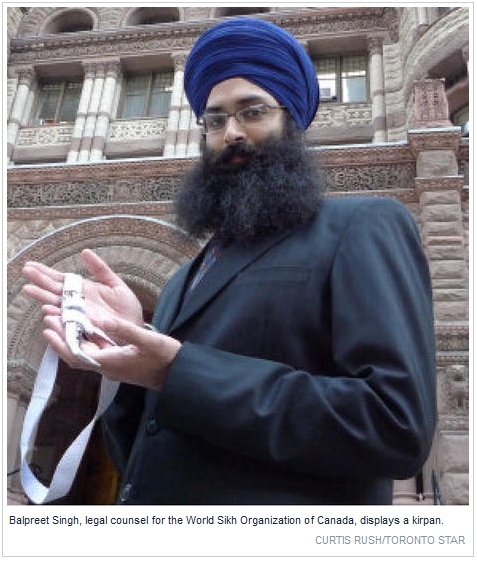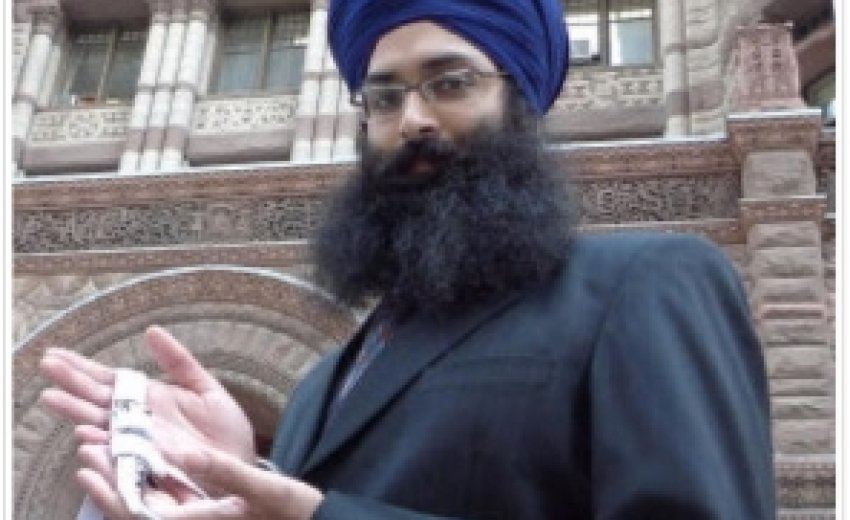 Wed May 16 2012: Toronto police have developed a formal policy allowing Sikhs to bring their ceremonial daggers into courthouses.
Wed May 16 2012: Toronto police have developed a formal policy allowing Sikhs to bring their ceremonial daggers into courthouses.
The policy, announced Wednesday by the Ontario Human Rights Commission and World Sikh Organization of Canada, contains some conditions, including subjecting anyone with a kirpan to a risk assessment.
The kirpan, which Sikhs describe as a stylized representation of a sword, may not exceed 20 centimetres in length, including the sheath. The blade must not exceed 10 centimetres.
The conditions satisfy Balpreet Singh, legal counsel for the World Sikh Organization of Canada.
“The risk of the kirpan being used as a weapon has been virtually eliminated in court,” Singh said.
The kirpan is carried by only 15 per cent of Sikhs in the GTA and it is worn everywhere, even in the bathtub and when sleeping, Singh said.
The kirpan, which represents spiritual wisdom and duty to stand against injustice, has an exaggerated curve at the end.
Its danger has sparked debate in Canada for years. Sikh leaders worried two years ago that an attack in Brampton with a kirpan would rouse objections over one’s right to wear the religious symbol.
The controversy first burst onto the national scene in 2001 when a 12-year-old Montreal student accidentally dropped his 20-centimetre kirpan at school, triggering a dispute with the school board over his right to wear it.
In 2006, the Supreme Court of Canada upheld his right in a landmark judgment.
Court security in Toronto was tightened following incidents — not involving kirpans — in the 1970s and 1980s.
In 1987, a Toronto lawyer was stabbed several times in the chest with a letter opener in the Osgoode Hall court building.
In 1982, two men were killed and another crippled after being shot at Osgoode Hall in a dispute involving rival factions in Toronto’s Sikh community.
The Toronto police policy was developed as a settlement of two human rights cases.
The first involved a Sikh who was to attend a mandatory class trip to the victim/witness assistance program at the Old City Hall courthouse. The student was denied entry because she would not remove her kirpan.
The second instance involved a Sikh man summoned for jury duty at the University Ave. courthouse and allowed to enter with his kirpan in the morning, but denied re-entry after lunch.
“This is a step in the right direction, combining respect for a person’s religious observances with accommodation principles and (Ontario Human Rights) Code obligations,” said Barbara Hall, chief commissioner of the Ontario Human Rights Commission.
Singh said he hopes to work with other police services in Canada to bring about a similar policy.
Local police services are responsible for court security in Ontario.
Although courthouses in other cities allow the kirpan, Toronto is the first to have a formal policy, Singh said.
NDP justice critic Jagmeet Singh (MPP-Bramlea-Gore-Malton) welcomed the news, saying he has put forward amendments to a bill that would solidify protection of religious accommodation in the province’s courtrooms.
“The largest population of practising Sikhs in Ontario and one of the largest in Canada lives in the Peel Region and the region has no formal accommodation right now,” Singh said. “It’s a big access-to-justice issue. There is no security threat by the kirpan and any minor concern that may exist may be accommodated by the Toronto example.”

